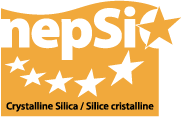Chapter 3 – The main kinds of RCS dust control
There are five main types of dust control.
We should follow the hierarchy of controls when applying them.
Tap the hotspots in the image to learn more about that level of the hierarchy.
There are five hotspots to explore, when you’ve read them all, move on!

Elimination
The most effective form of control, eliminating or removing the hazard.
Substitution
Substituting or replacing one hazard with a less hazardous one, in order to increase the safety of an activity.
Engineering controls
Reduction of exposure by isolating workers from the hazard and minimizing contact. Besides isolation, engineering controls include the use of ventilation systems to extract the dust from the air before exposure occurs, or replace dusty air with clean air. Also included are water suppression systems that dampen the material to prevent dust from being given off.
Administrative controls
Changing and improving the way people work to optimize processes and reduce exposure. Examples of this include job rotation and regular breaks, or access restrictions to the workplace in order to reduce the duration, frequency and severity of exposure. Developing safe working practices and providing training are also important parts of this process.
Personal protective equipment (PPE)
PPE protects only the wearer and relies upon individual action to be successful.
